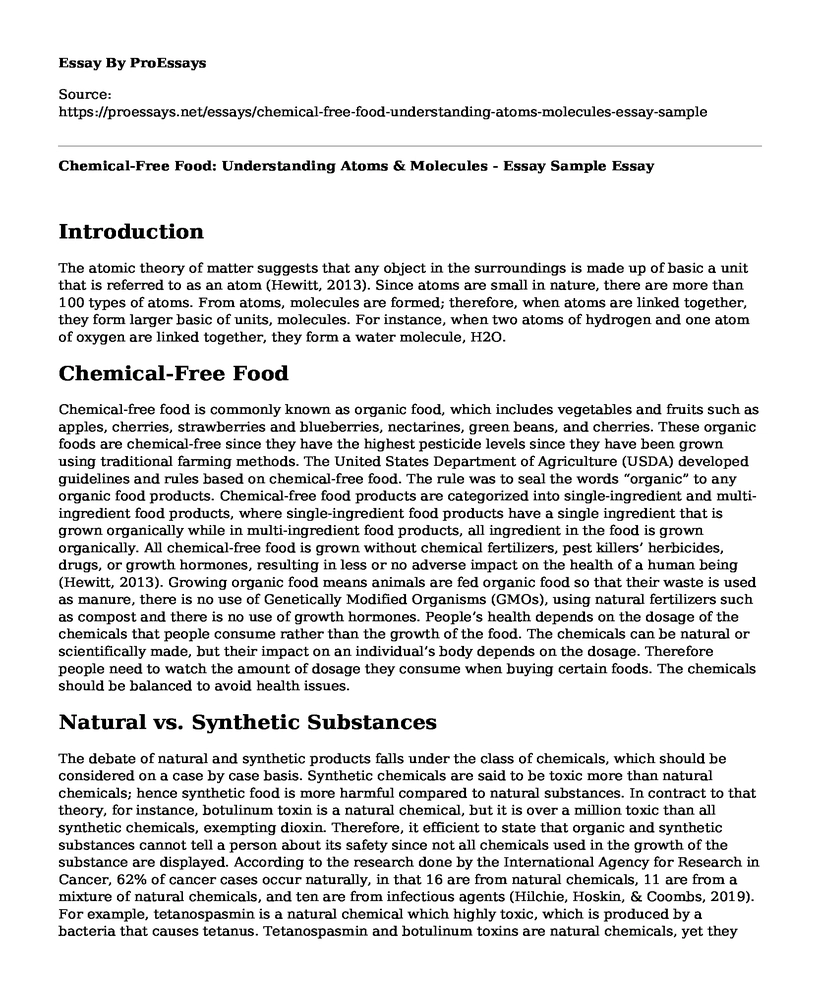Introduction
The atomic theory of matter suggests that any object in the surroundings is made up of basic a unit that is referred to as an atom (Hewitt, 2013). Since atoms are small in nature, there are more than 100 types of atoms. From atoms, molecules are formed; therefore, when atoms are linked together, they form larger basic of units, molecules. For instance, when two atoms of hydrogen and one atom of oxygen are linked together, they form a water molecule, H2O.
Chemical-Free Food
Chemical-free food is commonly known as organic food, which includes vegetables and fruits such as apples, cherries, strawberries and blueberries, nectarines, green beans, and cherries. These organic foods are chemical-free since they have the highest pesticide levels since they have been grown using traditional farming methods. The United States Department of Agriculture (USDA) developed guidelines and rules based on chemical-free food. The rule was to seal the words “organic” to any organic food products. Chemical-free food products are categorized into single-ingredient and multi-ingredient food products, where single-ingredient food products have a single ingredient that is grown organically while in multi-ingredient food products, all ingredient in the food is grown organically. All chemical-free food is grown without chemical fertilizers, pest killers’ herbicides, drugs, or growth hormones, resulting in less or no adverse impact on the health of a human being (Hewitt, 2013). Growing organic food means animals are fed organic food so that their waste is used as manure, there is no use of Genetically Modified Organisms (GMOs), using natural fertilizers such as compost and there is no use of growth hormones. People’s health depends on the dosage of the chemicals that people consume rather than the growth of the food. The chemicals can be natural or scientifically made, but their impact on an individual’s body depends on the dosage. Therefore people need to watch the amount of dosage they consume when buying certain foods. The chemicals should be balanced to avoid health issues.
Natural vs. Synthetic Substances
The debate of natural and synthetic products falls under the class of chemicals, which should be considered on a case by case basis. Synthetic chemicals are said to be toxic more than natural chemicals; hence synthetic food is more harmful compared to natural substances. In contract to that theory, for instance, botulinum toxin is a natural chemical, but it is over a million toxic than all synthetic chemicals, exempting dioxin. Therefore, it efficient to state that organic and synthetic substances cannot tell a person about its safety since not all chemicals used in the growth of the substance are displayed. According to the research done by the International Agency for Research in Cancer, 62% of cancer cases occur naturally, in that 16 are from natural chemicals, 11 are from a mixture of natural chemicals, and ten are from infectious agents (Hilchie, Hoskin, & Coombs, 2019). For example, tetanospasmin is a natural chemical which highly toxic, which is produced by a bacteria that causes tetanus. Tetanospasmin and botulinum toxins are natural chemicals, yet they are the most toxic chemical than synthetic chemicals in the human body. Natural and synthesis compound has the same chemical structure that it is to be supplemented as part of Vitamin C. for example; Vitamin E is naturally derived from d-a-tocopherol and synthetically derived from dl-a-tocopherol. The difference “dl” is the mixture of d-and l-a-tocopherol, in which there is no clear evidence that states that “l” is harmful to a person’s body which makes synthetic vitamin E to be less effective than the natural Vitamin E. From this theory, both natural and synthetic substance cannot tell if it is safe due to the level of toxicity and the chemical compound which après to be similar to each other.
References
Hewitt, P. G., Lyons, S., Suchocki, J., & Yeh, J. (2013). Conceptual integrated science. Pearson.
Hilchie, A. L., Hoskin, D. W., & Coombs, M. P. (2019). Anticancer Activities of Natural andSynthetic Peptides. In Antimicrobial Peptides (pp. 131-147). Springer, Singapore.
Cite this page
Chemical-Free Food: Understanding Atoms & Molecules - Essay Sample. (2023, Aug 21). Retrieved from https://proessays.net/essays/chemical-free-food-understanding-atoms-molecules-essay-sample
If you are the original author of this essay and no longer wish to have it published on the ProEssays website, please click below to request its removal:
- Intuitive Eating Essay
- Vegetarianism Versus Meat-Eating Essay
- French Pistachio Macaron Cooking Essay
- Essay Sample on Kentucky Fried Chicken (KFC)
- Essay Sample on Food Waste in UK
- Essay Example on Achieving Healthy Living: Exercise & Healthy Eating
- Starbucks: Tech-Driven Competitive Advantage & Porter's Five Forces - Essay Sample







